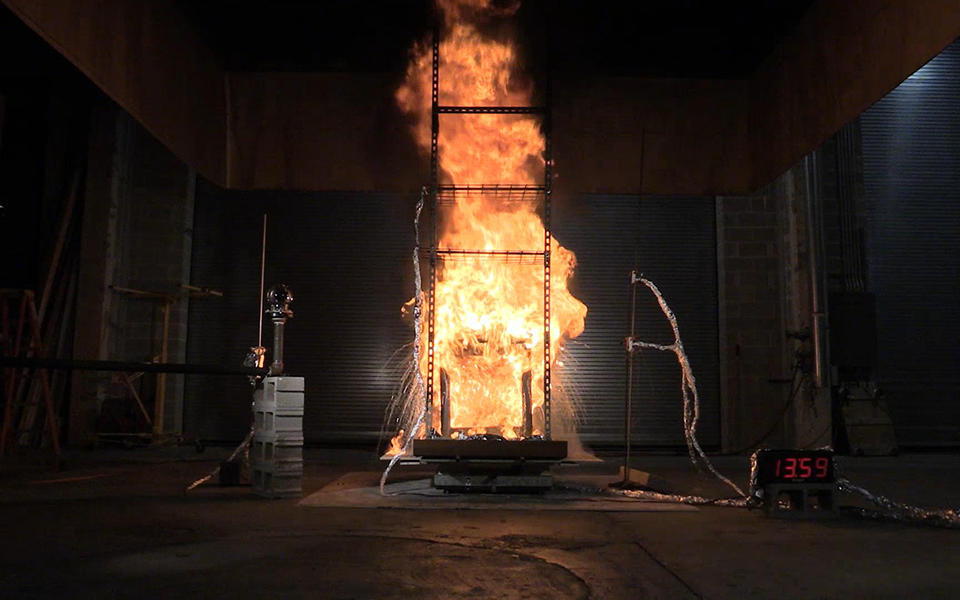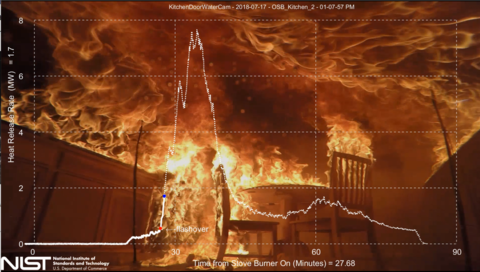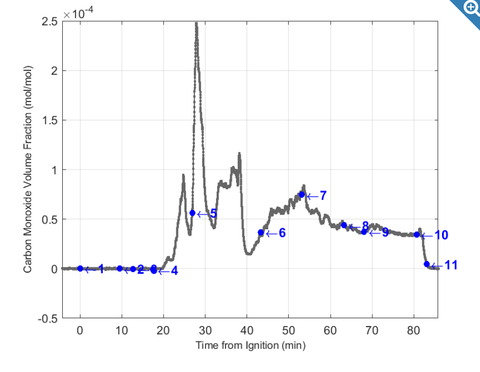Taking Measure
Just a Standard Blog
The New NIST Fire Calorimetry Database Is Available to Answer Your Burning Questions

Burning plastic cart carrying a fax machine, a laptop computer and a 3-ring binder.
Several centuries ago, scientists discovered oxygen while experimenting with combustion and flames. One scientist called it “fire air.” Today, at the National Institute of Standards and Technology (NIST), we continue to measure oxygen to study the behavior of fires. The NIST National Fire Research Laboratory (NFRL) has four progressively larger canopy hoods that are used to research the behavior of fires. The hoods, like massive lungs, suck in fresh air to give life to the fire under our watchful eyes. We carefully document these unique experiments using multiple cameras and up to several hundred measurement sensors. The hoods’ exhaust enters a series of long metal ducts where the gases and particles are carefully measured before they are scrubbed clean and returned to the outside.
The size of a fire, quantified as the heat release rate, is measured in watts. There are many ways to determine fire size, but one versatile and accurate method, pioneered at NIST in the 1970s, is to capture all the smoke from a fire and measure the amount of oxygen the fire consumes. This method is based on the observation that, for a wide range of combustible materials, the thermal energy produced by a fire is proportional to the mass of oxygen it consumes. The “oxygen consumption calorimetry” test method is now widely adopted as a tool for studying fires and developing of materials with improved fire performance. In the NFRL, we can make measurements of fires up to 20 million watts in size, enough to study fire growth in multistory buildings.

Measuring the size and growth rate of a fire is important for many reasons. Fire protection system design and regulation of flammable materials hazards can be improved with accurate knowledge of fire growth in specific scenarios. Computer simulations of fires often need fire growth rates as input, and fire model developers rely on accurate fire measurements for validation. These models are used for the design of fire safety systems such as sprinklers or smoke control fans, and in some cases the design of building structural systems. Fire models have also been used in forensic studies to investigate the cause and timeline of a fire.

I am proud and excited about the recent release of the Fire Calorimetry Database (FCD). This living database of real-scale fire experiments provides the public with free and open access to fire calorimetry results. The FCD contains experiments ranging in scale from small single items to fully furnished rooms. Each experiment contains detailed documentation about methodology and uncertainty. In addition to the fire heat release rate, we provide other fire properties such as the generation of soot particles and carbon monoxide gas. Users of the FCD can view experiments in a time-compressed high-resolution video augmented with data and time stamps.

Transition of these complex datasets from internal research resources into a tool for wider public use required a team effort. Over the past several months, a core team of NFRL staff has collaborated with colleagues in NIST’s Office of Information Systems Management to build the software infrastructure to share these data over the NIST website. The interaction between fire researchers and information technologists was fun and rewarding, pushing us all to clearly communicate outside of our normal areas of expertise.
I started my career at NIST in the late 1990s and wrote basic computer code to analyze experimental results from bench-scale fire experiments. Over my career I have been involved with increasingly larger and more challenging experiments and have continued to develop computer code to analyze experimental results. The development of the FCD has been personally rewarding since it reflects this journey.
We hope this media-rich database will allow users to gain insight beyond what they may find reading a traditional publication. We anticipate that the FCD will be used by practicing engineers and researchers to better understand and control fires; however, I am curious what other audiences will find and use this resource. I would love to see examples in which data from the FCD are being used for education, training or some other benefit to society.
About the author
Related Posts
Comments
Hi Mark,
Thanks! We will be adding more data soon and happy to hear the positive feedback.
Matt
Hi Matthew
Gerardo Crespo from Argentina writes to you, thanking you for sending such important information for the training of Firefighters in my Country, the work they carry out is excellent.
My regards to your person and team.
Hi Gerardo,
Thanks for your dedication to fire safety! We are glad you find this resource useful. Best wishes.
Great work and very good information to use in understanding the progression of fire. I visited NIST when I was a student at the National Fire Academy while enrolled in the Fire Modeling and Fire Dynamics course. The trip to NIST and your Fire Research building was very impressive.
Thanks for the work you do.






Matt,
Great job on publishing a very much needed, high quality, Fire Calorimetry data base. I plan on sharing this with in the NRC. In addition to being useful for developing performance based design fire scenarios, (e.g. NFPA 805) the data base will be equally useful in supporting Fire Probabilistic Risk Assessments (PRA) and NRC's Significance Determination Process (SDP) used for determining the severity of inspection findings. Kudos, I look forward to the data base continuing to grow and catalogue high quality data.